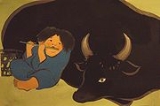
Kamisaka Sekka
Encyclopedia
was an important artistic figure in early twentieth-century Japan
. Born in Kyoto
to a Samurai
family, his talents for art and design were recognized early. He eventually allied himself with the traditional Rimpa school of art. He is considered the last great proponent of this artistic tradition. Sekka also worked in lacquer and in a variety of other media.
 As traditional Japanese styles became unfashionable (such as Rimpa style), Japan implemented policies to promote the country's unique artistic style by upgrading the status of traditional artists who infused their craft with a dose of modernism. In 1910, Sekka was sent by the Japanese government to Glasgow where he was heavily influenced by Art Nouveau
As traditional Japanese styles became unfashionable (such as Rimpa style), Japan implemented policies to promote the country's unique artistic style by upgrading the status of traditional artists who infused their craft with a dose of modernism. In 1910, Sekka was sent by the Japanese government to Glasgow where he was heavily influenced by Art Nouveau
. He sought to learn more about the Western attraction to japonisme, and which elements or facets of Japanese art would be more attractive to the West. Returning to Japan, he taught at the newly opened Kyoto Municipal School of Arts and Crafts, experimented with Western tastes, styles, and methods, and incorporated them into his otherwise traditional Japanese-style works. While he sticks to traditional Japanese subject matter, and some elements of Rimpa painting, the overall effect is very Western and modern. He uses bright colors in large swaths, his images seeming on the verge of being patterns rather than proper pictures of a subject; the colors and patterns seem almost to 'pop', giving the paintings an almost three-dimensional quality.
Japan
Japan is an island nation in East Asia. Located in the Pacific Ocean, it lies to the east of the Sea of Japan, China, North Korea, South Korea and Russia, stretching from the Sea of Okhotsk in the north to the East China Sea and Taiwan in the south...
. Born in Kyoto
Kyoto
is a city in the central part of the island of Honshū, Japan. It has a population close to 1.5 million. Formerly the imperial capital of Japan, it is now the capital of Kyoto Prefecture, as well as a major part of the Osaka-Kobe-Kyoto metropolitan area.-History:...
to a Samurai
Samurai
is the term for the military nobility of pre-industrial Japan. According to translator William Scott Wilson: "In Chinese, the character 侍 was originally a verb meaning to wait upon or accompany a person in the upper ranks of society, and this is also true of the original term in Japanese, saburau...
family, his talents for art and design were recognized early. He eventually allied himself with the traditional Rimpa school of art. He is considered the last great proponent of this artistic tradition. Sekka also worked in lacquer and in a variety of other media.

Art Nouveau
Art Nouveau is an international philosophy and style of art, architecture and applied art—especially the decorative arts—that were most popular during 1890–1910. The name "Art Nouveau" is French for "new art"...
. He sought to learn more about the Western attraction to japonisme, and which elements or facets of Japanese art would be more attractive to the West. Returning to Japan, he taught at the newly opened Kyoto Municipal School of Arts and Crafts, experimented with Western tastes, styles, and methods, and incorporated them into his otherwise traditional Japanese-style works. While he sticks to traditional Japanese subject matter, and some elements of Rimpa painting, the overall effect is very Western and modern. He uses bright colors in large swaths, his images seeming on the verge of being patterns rather than proper pictures of a subject; the colors and patterns seem almost to 'pop', giving the paintings an almost three-dimensional quality.

